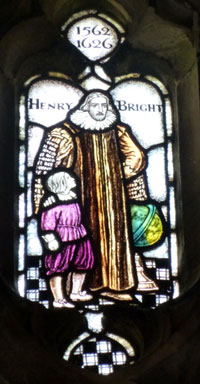Halt, stranger, and read. Over the inscription is the coat of arms thus described by Dingley [temp. Charles II.] in his History from Marble, "Az. a fess wavy erminois, in chief 3 crescents." The monument is now affixed to the wall of the north aisle of the Cathedral, though the body lies near the great north pillar of the belfry. |
Wall monument to Henry Bright in Worcester Cathedral, with Latin epitaph by Joseph Hall, Dean of Worcester. |
Henry Bright [1562 – 4th March, 1627] was a clergyman and schoolmaster in Worcester.
He served for 38 years Headmaster at The King's School, Worcester, and is mentioned by Thomas Fuller and Anthony Wood as an exceptional teacher, particularly of Latin, Greek and Hebrew. The period was at the height of Neo-Latin writing and Latin medium teaching. Many of his pupils are notable for their faculty in Latin and Greek and their impact on theological matters.Bright was baptised at the Church of St. Peter the Great in Worcester on 26 October 1562. He was the eldest son of James Bright, son of Nathaniel Bright (1493–1564). He was educated at King's Worcester himself, and matriculated at Brasenose College, Oxford as a "plebeian" in 1580, aged 18. Having moved to Balliol College, Oxford, he graduated B.A. (1584) and M.A. (1587), and was elected to a fellowship at Balliol in 1585.
Starting at King's Worcester in 1589, he also held a number of preferments in the church, including the rectories of Broadwas (1591), Tredington (1606) and Warndon (1615), and canonries at Hereford Cathedral (1607)and Worcester Cathedral (1619). In 1609 he purchased the estate of Brockbury in the parish of Colwall, Herefordshire. He died on 4th March, 1627.
Bright, Henry, of co. Worcester, pleb. Brasenose Coll., matric. - entry under date 12 Dec, 1580, aged 18; B.A. from Balliol Coll. 17 Jan., 1583-4, M.A. 27 Jan., 1586-7 (eldest son of James and grandson of Nathaniel Bright, of Worcester), rector of Broadwas, co. Worcester, 1591, of Tredington
1606, canon of Hereford 1607, rector of Warmington, co. Worcester, 1615, canon of Worcester 1619, until he died 4 March, 1626-7, father of Robert 1634. See Le Neve, iii. 83 ; & Foster's Index Ecclesiasticus.
Marriages and children:
Bright married twice. Firstly he married Maria Tovey, by whom he had a daughter:
• Mary Bright
Secondly he married Joan Berkeley, a daughter of Rowland Berkeley MP and a sister of Sir Robert Berkeley MP, the judge. They had a son and three daughters:
• Robert Bright (1617–1665), son and heir
• Dorothy Bright
• Joyce Bright, who married John Brydges (1604–1669) – they had three daughters, Brydges' coheirs
• Catherine Bright
Robert Bright inherited the estate of Brockbury, which remained in the family for many centuries, passing down to Henry Bright MP (1784–1869), then to the Oxford historian James Franck Bright (1832–1920).Kings School , Bright House was named in honour of King’s celebrated sixteenth-century Headmaster, Henry Bright.
With the increase of pupil numbers at King’s after the Second World War, the two existing Day Boy Houses Chappel and Creighton grew to an unwieldy size. In 1961 Mr. Annett (HM 1959-1979) decided to cut Middle School dayboys out of houses and divide the two sets of Senior School dayboys into four.From Chappel House, Mr. Annett formed Bright House, with orange for its colour. The House was named in honour of King’s celebrated sixteenth-century Headmaster, Henry Bright (HM 1589-1627), whose tenure was described in Alex Macdonald’s 1936 history of King’s as “the golden age of the school”.
Henry Bright was baptised in the Worcester church of St Peter the Great on 26 October 1562, and was himself a pupil at King’s. In 1580 he matriculated at Brasenose College but evidently switched colleges, as when he took his BA in January 1584 he was a student at Balliol. He took his MA three years later. During his seven years in Oxford, Bright acquired considerable learning in Greek, Latin and Hebrew. In 1589, after ordination, he was appointed as headmaster at King’s, aged 26. In his 38 years as headmaster he achieved a national reputation and was still being applauded long after his death on 4 March 1626/7.
Henry Bright, as depicted in a window in Worcester Cathedral Cloisters.
Reproduced by permission of the Chapter of Worcester Cathedral
Henry Bright for 40 years master of the King’s School at Worcester; and upon whom, according to Penn, a Coat of Arms was bestowed by the King “for that he was a most excellent scholar and rare teacher of the tongues.” It is noticeable that the “Arms” as granted were without “crest,” as if to mark recognition of the civilian in lieu of customary military service.
The Chapter marked appreciation of his services by presenting him in 1591 to Broadwas, which he held for 16 years. The King, in addition to coat of arms, gave him in 1618 a prebendal stall, and when he passed, the Chapter honoured him with grave and memorial in the Cathedral.
©peh



